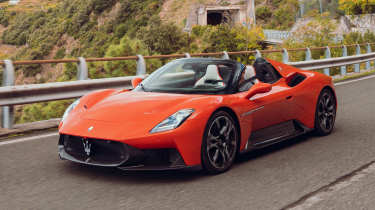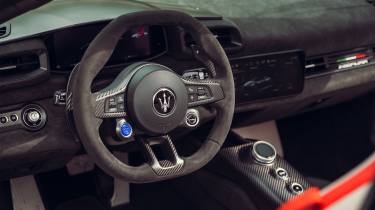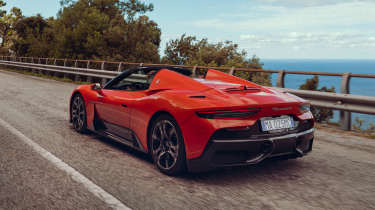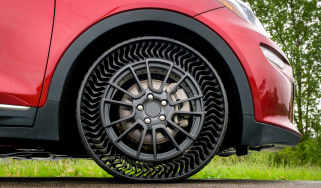Maserati MCPura review – redemption for the MC20?
The Maserati MC20 took top honours at evo Car of the Year 2022, but since then it’s been overshadowed by McLaren and Ferrari’s latest and greatest. Can its replacement – the MCPura – put that right?
Back in 2022, on the Scottish borders in mixed conditions against the very best that McLaren, Ferrari and Porsche had to offer, the Maserati MC20 stole our hearts and won evo Car of the Year. Where did that come from? At the time Maserati was only offering the ageing GranTurismo and underwhelming saloons and SUVs, and out of nowhere came this completely bespoke and utterly bewitching carbon-tubbed creation with shades of F40 in its character. No motors, no batteries, just an unadulterated and pure supercar in an increasingly digital age. It was brilliant. Maserati was back.
Or was it? Earlier this year, with the afterglow of that eCoty win still surrounding it, we revisited the MC20 in a test against rival sports and supercars in Northumbria. We hadn’t driven one in a few years, and it wasn’t quite the car we remembered it to be. The bombastic personality was intact but it was missing finesse, and felt quite ragged at times – particularly compared to McLaren’s brilliant Artura. Hmm. Was it the roads, or the context of the other cars on the test that exposed these rough edges? Maybe the fact that this particular MC20 wasn’t box fresh, having lived a hard life in the hands of other journos, played a part. It was and still is a stellar supercar, but the magic it delivered at eCoty was harder to pin down.
The MCPura is Maserati’s chance to win us back. It’s an updated MC20 in all but name, and supposedly leans into that car’s role as a daily usable supercar, an aspect that Maserati says took some customers by surprise. As such the styling has been tightened up, the interior has been updated…and not much else. Maserati says that in the interest of preserving the MC20’s approachable nature, no changes have been made under that carbon skin – the MCPura’s mechanicals are identical, but we wouldn't be surprised if engineers have made hidden tweaks to software and calibration systems while they had the chance. If the end result is a fighting fit, polished MC20, there won’t be much reason to complain.
More reviews
Group tests
- Lotus Emira Turbo SE v Alpine A110 GTS – two of the last surviving mid-engined sports cars
- Alpine A290 v Alpine A110 – how much DNA do they really share?
- Ariel Atom 4R v Caterham Seven ‘evo25’: power-to-weight heroes go head-to-head
- Ariel Atom 4 v Caterham Seven 310R v Lotus Elise Cup 250
- £200,000 supercar shoot-out: AMG v Aston Martin v Maserati v McLaren
- Audi Quattro, RS2 and RS3: five-cylinder icons head-to-head
- Who makes the best GT car? Aston Martin v Bentley v Maserati
- Caterham Super Seven 600 v Super Seven 2000
- Corvette Stingray v Porsche Cayman GTS v Audi R8 RWD
- Great Ferrari hypercars driven: 288 GTO, F40, F50 and Enzo head-to-head
In-depth reviews
- Abarth 600e 2025 review – Italy gives the Alpine A290 something to worry about
- Alpine A110 review – the sports car Lotus should be building
- Aston Martin Vantage 2025 review – a thrilling Mercedes-AMG GT and 911 Turbo S alternative
- Audi R8 (2015 - 2024) review – the ultimate soft-focus supercar
- BMW iX 2025 review – the ugly duckling still stomps the Tesla Model X
Long term tests
- Abarth 695C Turismo Fast Fleet test – living with the charming Italian hatch
- Alfa Romeo Giulia Veloce long term test – can Italy beat Germany?
- Alpina B10: Alpina B10: end of term report
- Aston Martin Vantage (2006) Fast Fleet test – living with a £30k V8 Aston
- Caterham Seven evo25 Fast Fleet test – living with a track car for the road
- Caterham Seven evo Edition revealed – bespoke 420R joins the Fast Fleet
- Cupra Leon 300 Fast Fleet test – living with Spain's 300bhp hot hatch
- Cupra Ateca VZN Fast Fleet test – four months with Cupra's hot crossover
- Cupra Leon Estate 310 4Drive Fast Fleet test – living with the 306bhp hot estate
- Ford Mustang GT
Review
- New Bentley Batur 2023 review – can it possibly be worth £1.65m?
- 2023 Chevrolet Corvette C8 Z06 review – the American 911 GT3?
- BBR Supercharged Mazda MX-5 (ND) 2023 review – tuned 250bhp roadster driven
- MG4 Trophy 2023 review
Reviews
- Abarth 695 75 Anniversario edition 2024 review – a fitting send-off for Abarth’s hot supermini?
- Abarth 500e 2023 review
- AC Cobra 378 Superblower MkIV 2021 review – another V8 Cobra, but with a GM heart this time
- Acura Integra Type S 2024 review – a Honda Civic Type R with added restraint
- Alfa Romeo Giulia 2025 review – get one while you still can
- Alfa Romeo 33 Stradale 2025 review – a rare Italian jewel beyond compare
- Alfa Romeo SZ: history, review and specs of an icon
We're driving the MCPura in Italy, and Maserati’s designated test route initially takes us through towns and a few miles of autostrada. Not particularly exciting, but it's a good demonstration of the MCPura’s bandwidth. It's calm, undemanding and deeply special to be in. In GT mode the steering is light, the damping is supple and it doesn’t feel especially wide, because you can place it with easy precision. And under short bursts of acceleration you get hints of the Nettuno V6’s character, whooshes and flutters from the turbo layered on top of bassy exhaust grumble. It still develops 621bhp – quite modest in a world of 800bhp+ junior Ferraris – but there’s still a sense of massive potential when you sink into the throttle. The sound is more present in the Cielo version we’re driving, with its retractable hard top and drop-down rear window, which you can operate with the roof up. At 1560kg it’s 85kg heavier than the coupe.
So far so familiar. One area of the MC20 that really didn’t justify its price and halo status was the interior, and sadly that’s still the case. There are more alcantara surfaces in the MCPura and a new wheel with a flat top and bottom, but fundamental snags remain – cheap-feeling switchgear (even down to the central drive mode selector, which should be the centrepiece of the cabin) and a tacked-on infotainment screen borrowed from a Fiat 500. Oh, and the butterfly doors extend too far outwards when swinging them open in a car park, more so than, say, a McLaren’s. Which is the very definition of a first world problem.
Still, once you’re settled in it’s hard not to fall for the MCPura's bristling personality, and when dialled up to Sport – or particularly Corsa – it really comes to life. The roads here are littered with imperfections but the surface isn’t as gnarly and three-dimensional as those in the UK, so you can find a wonderful rhythm with the MCPura, bursting between corners under the pull of the V6 and picking precise lines, enjoying its poise and flow. In Corsa there’s a fierce energy to the powertrain, the exhaust becoming more vocal and the throttle being more reactive, the eight-speed DCT punching gears home with a thump through the car. This does add drama but the changes in GT are more seamless and don't upset the car as much.
But as quickly as your confidence and commitment grows in the MCPura, it takes a plunge when you first stand on the brakes at speed for a slow corner. Like the last MC20 we drove, the brake-by-wire system lacks feel and bite at the top of its travel, which is unsettling when trying to bleed off just the right amount of speed. You don’t get the stopping power you expect until you’re deep into the pedal, which can lead you to braking further into corners than is ideal to get it slowed down. Whether it’s a limitation of the brake-by-wire system or the preferred feel for Maserati engineers, the brakes should be intuitive and reassuring in a car with so much potential, and they're not.
It’s a shame because once settled in a corner, there’s real subtlety and nuance to the MCPura. The steering is lovely, quick but not hyperactive with nicely judged weighting, and you can lean on the scrub from the front tyres, feed the throttle and precisely control the level of slip with your right foot. The explosive engine suggests this might be intimidating but it’s not, and you can use the power to get the rear moving almost imperceptibly. It can be more lairy with the ESC off but that’s not really it’s style – it’s more about flow and precision, playing with minute angles and picking the road apart with accuracy. In this sense the MCPura actually feels more finely balanced than the more extreme GT2 Stradale on the road, which feels like it has all its grip planted at the rear, and is trickier to drive in that sweet neutral zone as a result.
The limitations we found with the MC20 were the brakes (still not fixed) and ultimate suspension control on gnarly roads. In its softest settings it could ground out through compressions, but firmer modes disrupted the sense of flow. These roads aren’t an ultimate test of its control but the MCPura does feel more cohesive, not being jarring or harsh when stiffened up, with a feeling of strength in the structure as it picks off imperfections – with the proviso that UK roads might expose the cracks.
Here and now, though, it’s an easy car to fall for. Both the Ferrari 296 and McLaren Artura are more complete supercars, but the MCPura is one with a unique character that can happily lean into a GT-style role, and deliver an intense thrill when the moment comes to unleash it. It hasn’t quite stolen our hearts like it once did, but we’re glad it still exists as an unapologetically pure alternative to the hybrid norm.







